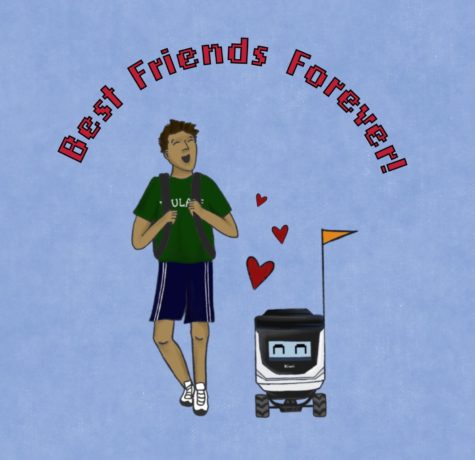OPINION | Are these delivery robots really necessary?
September 14, 2022

This year, in addition to the incoming class of freshmen, Tulane University welcomed a few other exciting new faces. Kiwibots are the latest four-wheeled additions to campus. These small delivery robots are a part of Tulane’s dining services and allow students to get food delivered from on-campus dining locations to wherever else they may be on campus.
While these little bots with animated expressions certainly seem futuristic rolling around the sidewalks, convenient food delivery is no novel concept. Many college students are likely familiar with — and grateful for — the ease that food delivery services provide.
Food delivery services such as Uber Eats, Grubhub and Postmates, among others, have allowed students to enjoy their favorite off-campus restaurants from the comfort of their dorm rooms.
These apps eliminate long walks or Ubers for tired students, but the food delivery robots skate the line between convenience and pure laziness.
Last year, Tulane students expressed dissatisfaction with Tulane dining when the university replaced Panera Bread with Dunkin’ Donuts in the Lavin-Bernick Center for University Life. Most students seemed disappointed in the lack of food options that would result from removing Panera. Students have not, however, ever expressed being bothered by the convenience or proximity of the LBC. Nevertheless, we now have delivery robots and, regretfully, still no Panera.
Questioning the motivation of the new addition to campus is equally as important as questioning the effects. Why did Tulane’s dining services decide to introduce Kiwibots? It hardly seems plausible that the motivation was to reduce student burden — seeing as the LBC is only several hundred feet from Tulane’s two largest freshman dorms.
Perhaps Tulane’s standing relationship with Sodexo can provide further information about the new arrivals. As many students are aware, a vast majority of Tulane’s dining and janitorial staff are employed by Sodexo, which has a contract with Tulane.
In February of 2022, Sodexo expanded its contact with Kiwibot, enabling the company to expand their fleet of robots at 50 college campuses across the US. With the help of Sodexo, Kiwibot plans to grow to over 1,200 bots from the current number of 200.
Maybe these robots provide some increased convenience, and maybe they look cute scooting around campus, but how can we be sure Tulane’s incentive for acquiring the robots is rooted in promoting ease in students’ lives?
Since the arrival of the Kiwibot fleet at Tulane, there have been a couple changes to campus. First, Rollin’ and Bowlin,’ the beloved smoothie bowl shop, has moved from its previous location on McAllister to join the other on-campus restaurants in the LBC food court. Now, the space where Rollin’ used to be is being used as a storage facility for the Kiwibots to recharge.
Whatever the initial reason for Tulane introducing the Kiwibots, and despite the limited information that we have about them, we should still analyze the costs and benefits of the delivery bots.
Unfortunately, due to a lack of information, there is little to analyze. We are left with more questions than answers. For instance, how frequently are students taking advantage of the Kiwibots service? How much energy does it take to charge the bots? What is the cost of the energy usage? Are students actively benefiting from this addition? Really, what it boils down to: who was this for?
Perhaps in the future — in the spirit of community transparency — Tulane will release more information and specific data about the Kiwibots. In the meantime, watch your step; a little black box might be rolling by on your walk to class.








Leave a Comment